Riders used to dread the thought of an indoor trainer that confined you to slogging out the miles in a quiet room with nothing but your thoughts and the pain in your legs for company. Nowadays, a steep progression in technology and the introduction of virtual reality riding thanks to programs like Zwift and TrainerRoad, the popularity of indoor cycling has skyrocketed. Indoor trainers are no longer just the savior of any cyclist that wanted to carry some form through the winter months without having to brave the less than ideal weather conditions, they now provide a fun interactive environment that can give you your social fix as well.
With this helpful guide, we'll explain the various types of indoor trainers, what sets them apart from each other and how to choose the right one for your needs.
Types
There are four items we consider to fit the description of an 'indoor trainer'; direct drive and tire drive trainers, rollers and complete indoor bicycle systems. Each device differs in road feel, noise, price, weight, footprint, connectivity, and compatibility. Below is a description of each.
Direct drive
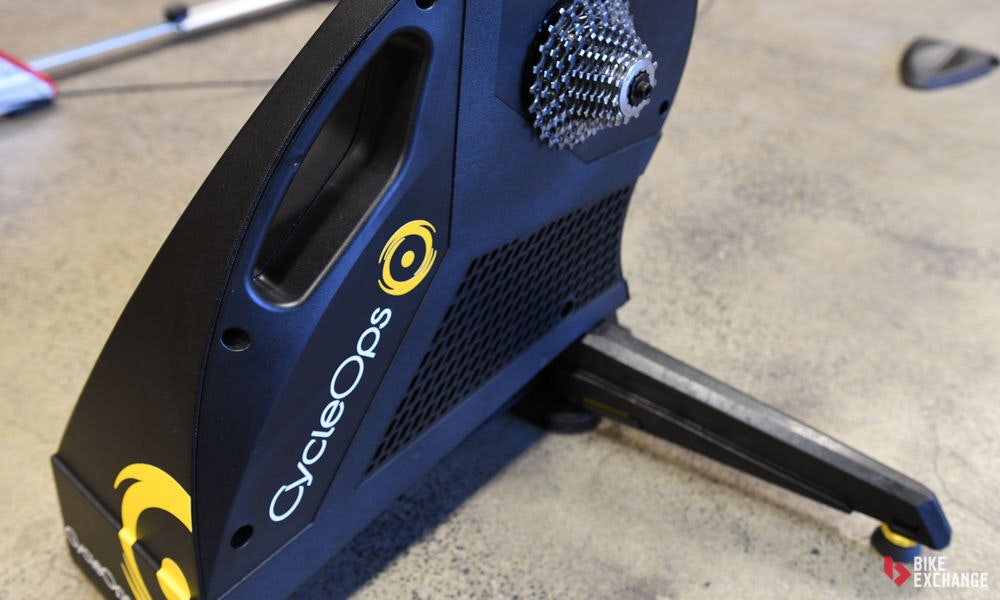
A direct drive trainer requires the removal of your bike's rear wheel and is connected via the rear dropouts. They require a cassette (rear cogs) to be installed directly on the trainer (that often isn't included). As with the majority of trainers, the resistance method (that we'll discuss below) can vary between wind, fluid and magnetic. Once connected, the trainer provides a solid platform and smaller total footprint (as the rear wheel is removed) than rollers or tire drive trainers.
The benefit of direct drive trainers is they save wear and tear on your rear tire and cassette (assuming you have a separate one for your bike), are easy to use and the latest models work with a wide variety of frame dropout standards. They also often provide a realistic ride feel and great stability under hard efforts. The downside of direct drive trainers is they are typically more expensive (especially once you factor in an additional cassette) and heavier than tire drive trainers, meaning you might have to find a permanent location for it.
Tyre drive
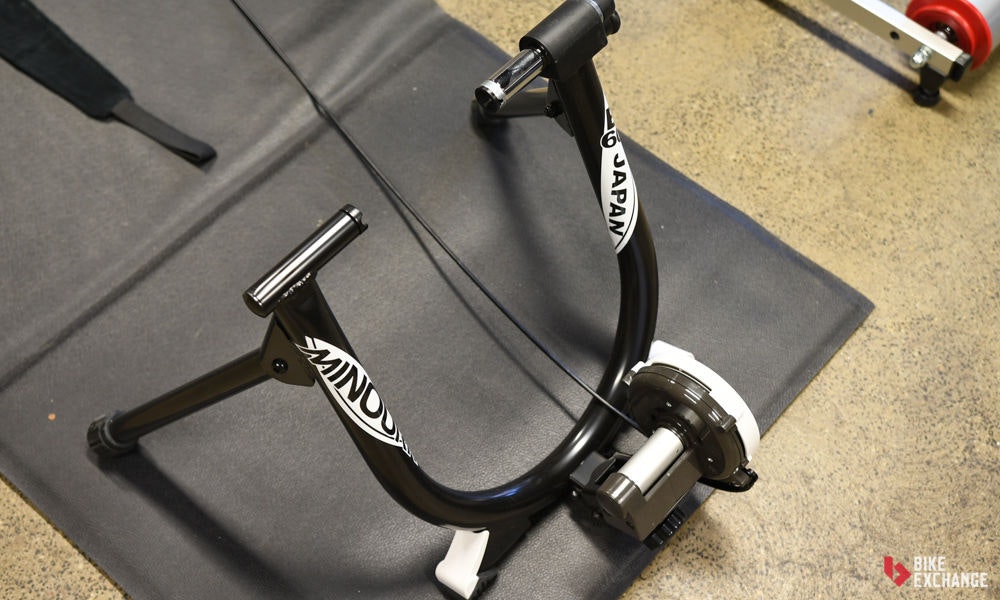
A tire drive trainer also connects to your bike via the rear dropouts, but instead clamp to the outside of a quick release lever or similar. The resistance comes from an adjustable roller that contacts your rear tire. These trainers also come with multiple resistance methods and are typically more cost-effective and lighter than direct drive trainers. The key downside of such a trainer is the additional wear caused to the center of your rear tire.
The lighter weight and small footprint make tire drive trainers great options for those looking to use a trainer as a means of warming up at events or for those who need to pack their trainer away after each use.
A rare alternative to excessive tire wear is a rim-drive trainer. This form of trainer provides resistance via rubber rollers that contact the sidewall (braking surface) of the wheel, not the tire itself. This can be a great option for mountain bikers and road riders alike, as you don't need to change wheels or tires to use the device. It's worth noting that this style won't work with all wheel types.
Rollers
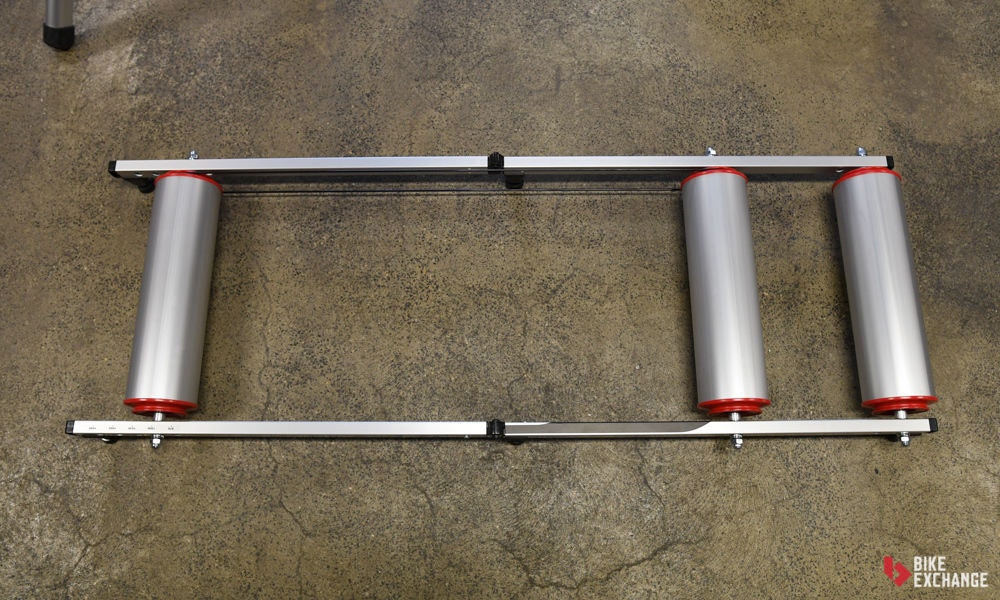
Rollers are the original indoor trainer and are still used by many to improve balance, pedaling efficiency and cycling specific core strength. They can also be more fun and realistic to ride than stationary trainers. Rollers feature three drums (one at the front and two at the rear), that spin as you pedal. Resistance is based on the size of the drums (smaller drums provide more resistance) or by gear selection of the rider, however, some premium models do offer internal resistance beyond this. They are incredibly simple in design but can be difficult to use as they require great balance and concentration.
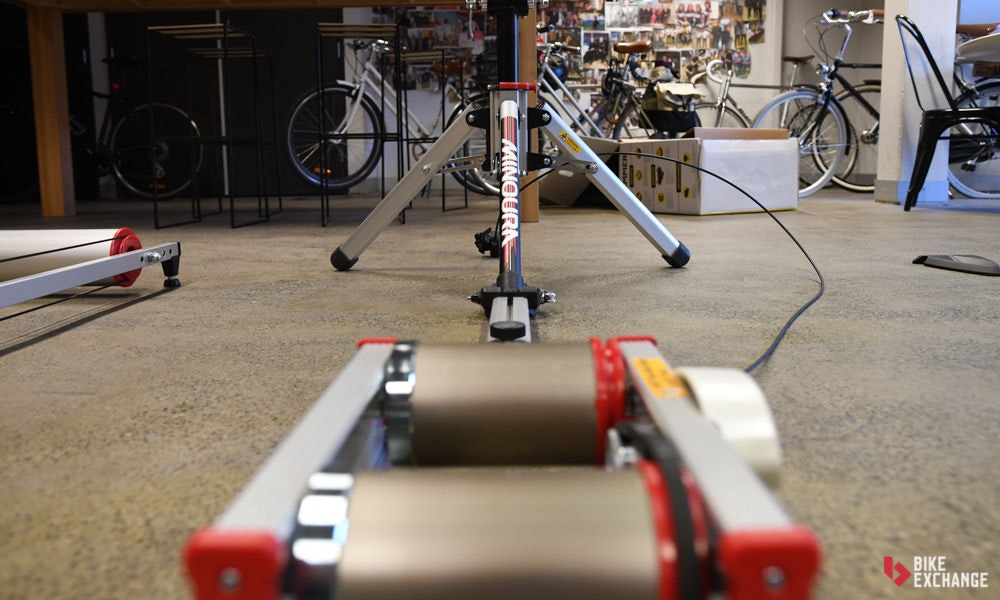
An alternate form of traditional rollers are 'hybrid' rollers. Basically, these are rollers out the back and with a fork dropout mount on the front, providing the feeling of rollers with the stability of a fixed trainer. Brands such as Minoura and Feedback Sports offer such a thing.
Complete systems
An alternative to indoor trainers is a complete indoor bike in the form of a Wattbike, exercise bike or spin bike. These bikes typically only feature one wheel with resistance coming from fluid, wind or magnets. The advantages of a complete indoor bike are there is no wear and tear on your actual bike; they are more stable than other trainer options; and most have integrated resistance control system and electronic screens. The disadvantages are the additional cost, with some models costing more than an actual bike; the large size and significant weight; and the additional purchases of pedals and potentially a seat. Some entry-level bikes also have limited scope for fit adjustment and in offering a realistic ride feel, which is not ideal for comfort or consistency when swapping to and from your actual bike.
Resistance types
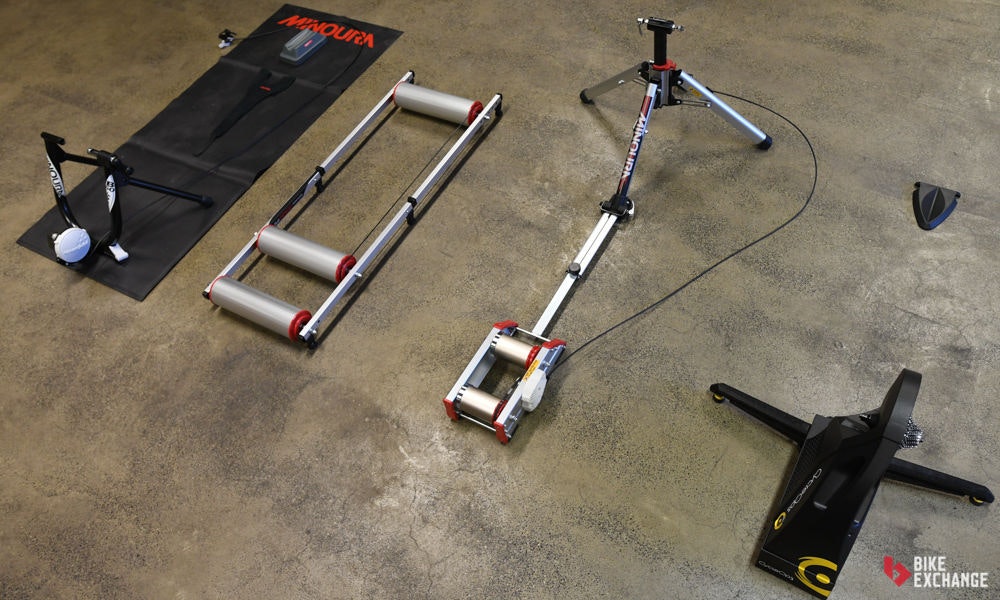
There are multiple types of resistance for trainers that affect cost, durability, realistic road feel, weight and the amount of noise produced. A summary of each is listed below to help you decide which is the right option for you.
Magnetic
Magnetic trainers use opposing magnets to provide resistance. A 'flywheel' complete with magnets spins around and past another series of magnets in a fixed position. As these magnets get closer together the opposing forces increase causing greater resistance for the rider. How this resistance is adjusted will dictate how expensive (or cost effective) a magnetic trainer is. Some models require riders to dismount and manually change the resistance on the rear of the trainer, others can be changed with a lever whilst on the bike and some (that we'll detail below) are controlled by an app or third party software, like Zwift and TrainerRoad.
It's worth pointing out the variables you'll likely encounter with flywheels. Generally, the heavier the flywheel is, the better the feel and the more expensive the trainer will be. Inertia is at the heart of the flywheel proposition, with a heavier wheel mimicking riding outside where it takes an effort to get the bike moving, and then it continues to roll once you are coasting. Lightweight flywheels don't spin as well, and so their rotation isn't as smooth or realistic. Flywheels can start at 1-2kg and extend to over 7kg for more expensive models.
Electronic
Electronic, or electromagnetic trainers, are an advanced, modern version of magnetic trainers. They still feature a magnetic flywheel and fixed magnets but are controlled electronically via remote or third party software. They are quiet and provide plenty of features that can be costly as a result.
Wind
Wind trainers were one of the first indoor trainers with a simplistic design that is both durable and cost-effective. Wind trainers work via a fan within the unit that produces resistance against the air as it spins. The harder the rider pedals, the greater the speed of the fan and greater resistance produced. The drawbacks of such a system include excessive noise production, lack of realistic road feel and non-adjustable resistance (aside from pedaling harder).
Fluid
Fluid trainers are often considered the most realistic of all trainers as the resistance produced by the fluid mimics that of the road. The fluid is normally turbine oil, which can better deal with the heat generated whilst pedaling. The fluid is housed within a chamber and a flat-bladed drive shaft that is powered by the pedaling action displaces the fluid. On the internal walls of the chamber are more, stationary flat blades which produce resistance. Similarly to the wind trainer, the harder you pedal, the more the resistance automatically ramps up. However, unlike wind trainers which eventually push all the available air out, fluid trainers are near impossible to over power,
Smart trainers
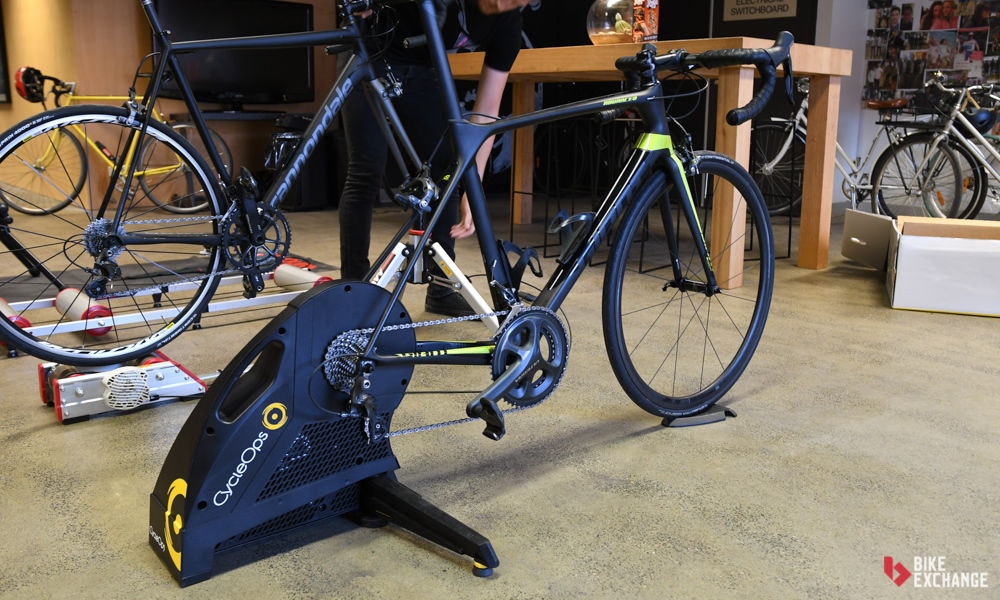
Smart trainers can be any of the above-mentioned options and are defined as trainers that have the ability to connect and communicate to external software and third party applications. With the right trainer and third party software, the external program can control the resistance and ride characteristics (like riding over Cobblestones or down a hill) of your trainer without you having to touch a button. Smart trainers are highly variable with different features and so we've outlined some important considerations below.
Connectivity: The ability to connect to external software is what sets these trainers apart from others and this is normally as a result of either ANT+, Bluetooth or a combination of the two. These programs allow for the wireless transfer of data such as speed, cadence, power, heart rate, etc. What's important to know is whether the trainer you are interested in uses ANT+ or Bluetooth or both as some third party applications will only use one or the other, hence they may not be compatible.
Power: Watts and power are seemingly everything to the modern day cyclist and so it stands to reason that maximum wattage and power accuracy are key performance indicators for any good smart trainer. Maximum power is pretty simple and refers to the maximum amount of power the unit can tolerate and record. Some trainers can handle over 2,000 watts and to put it into perspective, WorldTour riders rarely (if ever) hit those kinds of numbers. As a result, power accuracy and other factors like noise and flywheel weight are of more importance to the majority of us. Power accuracy is measured in a plus or minus percentage of the actual and reads like this: +/- 5%. The more accurate a trainer is the better, with some claiming accuracy of +/- 1%. Of course, the starting point for power and the method of measuring it differs from each unit and so the legitimacy of those claims need to be taken with a grain of salt. One thing to look for is how the power is measured, such as if it's via sensors or just estimated from an algorithm.
Slope: The trainer's ability to simulate a gradient is the 'slope' and the greater the capable slope, the better the trainer. Some trainers can simulate upwards of a 20% gradient, which in a similar manner to maximum power, is perhaps more than most of us require. Trainers with a 10% maximum slope is a good figure as this should be enough to accommodate the majority of third party application routes or rides you'll encounter.
Other considerations
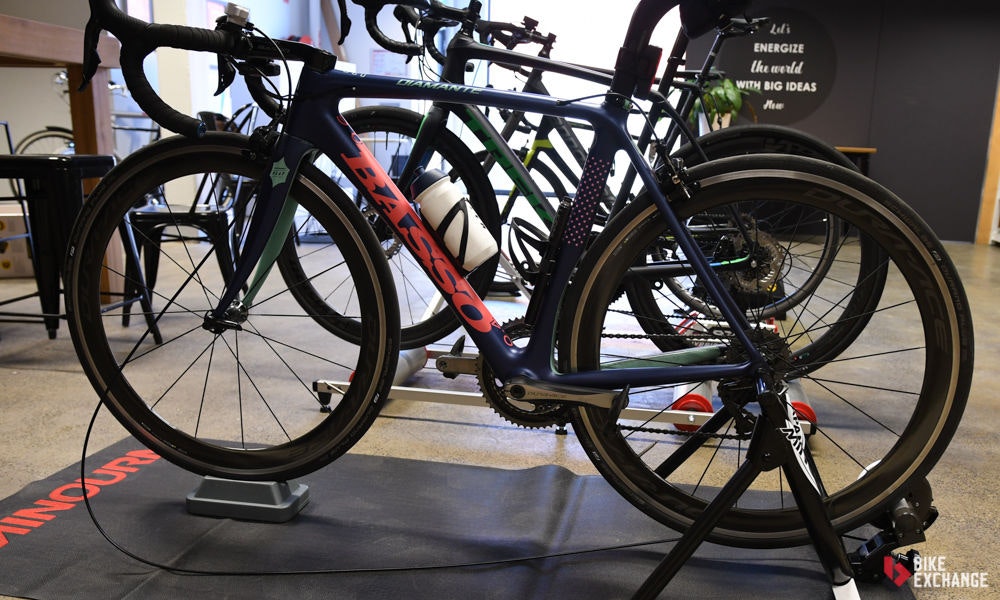
Now that you've got an understanding of the trainer and resistance types, it's time to consider other factors that could just as heavily influence your purchasing decisions. Below is a list of other considerations that will help you choose the right trainer for your needs and circumstances.
Noise produced
Depending on where you live, who you live with and how you plan to use your trainer, the amount of noise produced could be an important factor. All trainers will make some kind of noise despite claims of being 'silent' and typically wind trainers will be the loudest. Most trainers will list their decibel level at a given speed or cadence, so if you are trying to avoid upsetting neighbors or family members look for low numbers. And if comparing noise production of trainers, be sure to compare the decibel level at the same speed or cadence as there's no industry standard at which this is measured.
Footprint
The footprint describes the area covered by something and in trainer terms, the larger the footprint, the more stability created and the safer you'll be. The key dimension to look for is the width of the unit followed by the height and length. The width will create the stability to counterbalance the long length of you and the bike. Some units have foldable legs, which come in handy from a functional point of view, while others will remain locked in place. Less expensive trainers tend to have smaller footprints and some are considerably high creating further instability, which all compounds to your chances of tipping over. Tipping over is the last thing you want to happen when doing a hard effort or reaching for your phone from a nearby table.
The flipside to this is the trainer taking up too much space and becoming a nuisance. If you have a designated spot for it in a spare room, garage or your cycling cave, then this is less of an issue. But if space is sparse, opting for a trainer with a smaller footprint is recommended.
Weight
The weight associated with a trainer has two components; the weight of the actual trainer and the maximum weight it can hold.
The weight of the trainer is a key consideration if you plan on taking your trainer to events to serve as a warm-up. Many events take place on closed roads with limited opportunities to ride on surrounding roads, which could leave you short of a decent warm up before your event. As such, bringing a trainer along that you can easily set up next to your car or close to the race start is ideal. And that being the case, you don't want to be lugging around a cumbersome 30kg trainer to and from every event. If you plan on setting your trainer up in a permanent spot, then the weight isn't going to be an issue, and in fact, will likely aid stability. However, if mobility is a key consideration, be sure to check the weight first.
It's also important to check the maximum load the trainer can tolerate and how that measurement is defined. Some products will list a maximum weight load including the bike and riders, whereas others may only consider the rider.
Compatibility with a variety of bikes
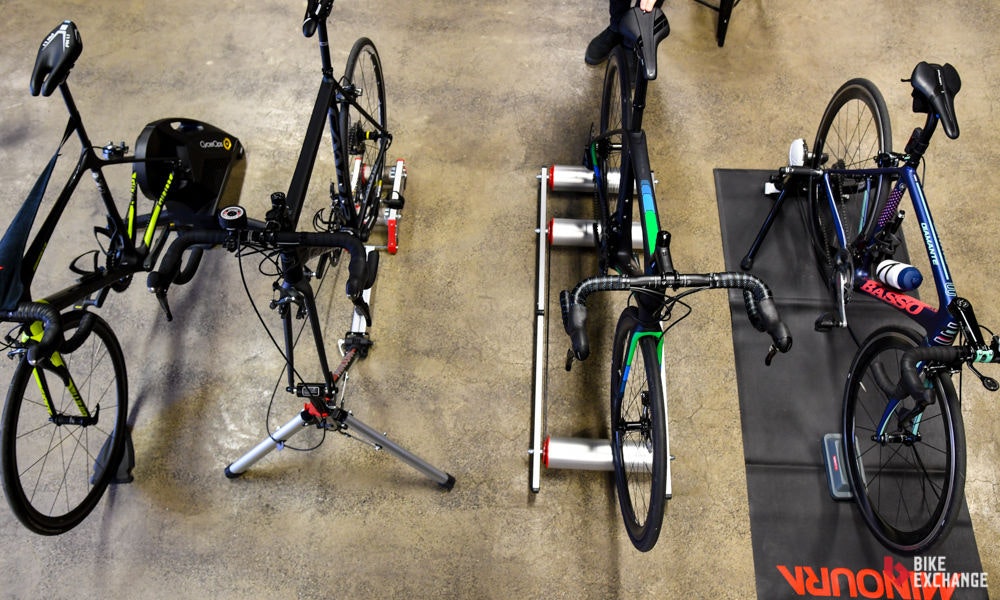
If you ride a variety of bikes, whether that be road, mountain, triathlon or cyclocross, then knowing that your bike is compatible with the mounting requirements of the trainer is crucial. Mountain and cyclocross bikes will typically have thru-axles, whereas road and triathlon bikes will typically have quick releases, both requiring different mounting options and widths. The latest and best trainers will be able to accommodate most forms of bikes but it's one to check if you plan on rotating bikes through or primarily use anything other than a standard road bike. The CycleOps Hammer, for example, is compatible with thru-axle bike frames with widths of 142mm or 148mm and is quick release compatible for bike frames with standard open dropouts of 130mm and 135mm widths, meaning it should fit just about all modern road, cyclocross, and mountain bikes.
Another consideration is ensuring the cassette on your direct drive trainer matches your bike in terms of gears. Pairing an 11-speed drivetrain with a 10-speed cassette, for example, won't work perfectly and may lead to damage of your parts.
Trainer Accessories
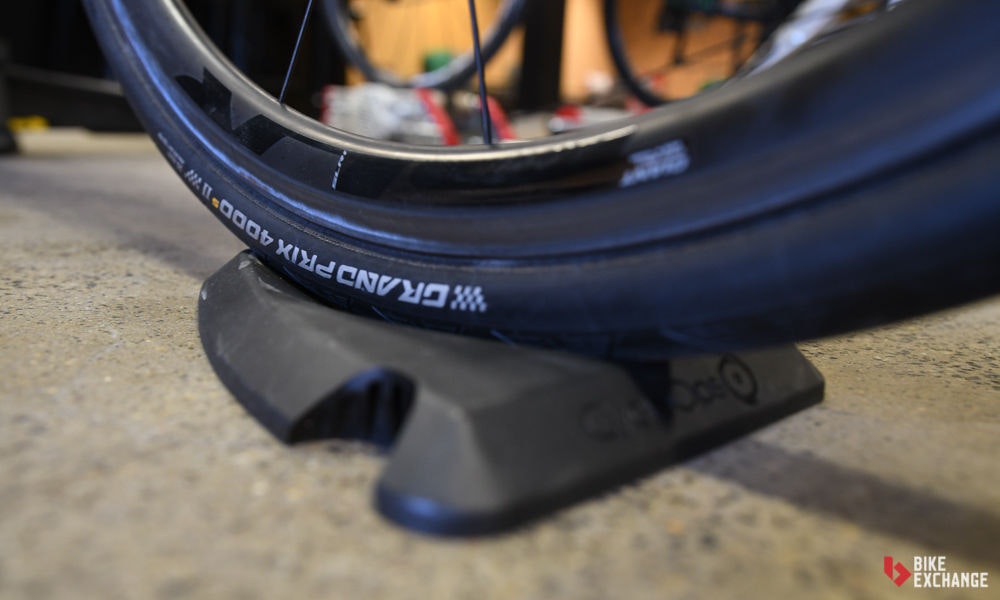
Now that you've decided on a trainer to suit your needs, below is a short list of possible accessories that could further enhance your indoor training experience.
Sweat guard: When you're out on the open road, the wind will blow sweat off you, but inside it will just drip directly onto your top tube. Sweat contains high levels of salt which is corrosive and can slowly work away at your bike's paintwork. To safeguard from this, a sweat guard or sweat net covers your top tube and catches droplets of sweat before they hit your bike and cause any damage.
Mat: A mat is used to protect your floor from wear and sweat. They are typically made from highly durable fabrics and as an added bonus, can also cancel out some of the vibration and noise created by the trainer.
Riser block: Many trainers (except most direct drive) will raise the rear of the bike, giving the impressions that you are riding downhill. To counter this, riser blocks are used to prop up the front wheel, leveling out your position. This not only feels more natural but also creates stability. They can even be used to increase the height of the front of the bike to simulate climbing a hill.
Trainer tire: A tire drive trainer will prematurely wear out your rear tire so a simple way to combat that is to purchase a specific trainer tire. These tires are thick and wear resistance to last longer and save your 'good' road tires. An alternative is to purchase a heavy duty road tire that features large amounts of tread and is used exclusively on the trainer.
Applications: With the rise of smart trainers came the rise of third party applications that are aimed at enhancing your indoor riding experience. Apps like Zwift allow you to ride with other people in a virtual world, and can even simulate drafting. Programs like TrainerRoad allow you to be ultra-specific with your sessions and act like a real-time coach. And a program like FullGaz has over 1,000 km of real-world terrain to explore. There's also BKool, Hurts Ergo, The Sufferfest, Tacx Training software, Wahoo Fitness, CycleOps Virtual Training and so many more.
Budget
Under $200
It is possible to get an indoor trainer for under $200 but don't expect the connectivity, automation, smoothness or durable of the more expensive options. Trainers at this level will be tire drive and any changes to resistance required to be performed manually. Information in the form of speed or cadence is unlikely so you'll be required to work off perceived effort or to timed intervals to get a solid workout.
$200 - $500
Trainers under $500 tend to be basic, lacking the automated controls and connectivity of the more expensive options but they still provide a great indoor solution to poor weather conditions or portable warm-up device. Some models close to $500 may provide basic levels of connectivity to third party applications but they won't be able to be controlled by these applications like the more expensive options. Expect speed and cadence information as a maximum.
Tire drive trainers, rollers and entry level complete indoor bike systems are all available at this price point but if you're after a direct drive trainer, then the next price bracket is for you. Trainers at this level will typically use levers or manual methods to control resistance, have a small footprint and be relatively light weight.
$500 - $1,200
All types of trainers are available at this price point and we see electronic resistance control introduced. Weight, footprint and noise production will be similar to more expensive trainer options but things like slope, power maximum and accuracy, and flywheel weight will be less. You can expect the following values for smart trainers in this price range; slope of approximately 10%, power accuracy of +/-5%, maximum power of up to 1,000w and a fly wheel weight of between 1kg - 4kg.
Over $1,200
The price of trainers can extend to well over $2,000 but the likely difference between an $1,500 trainer and an $2,500 trainer will be greater power accuracy and maximums, more slope capability and a heavier flywheel. Other factors like weight, noise production and durability will be similar.
These trainers will have power and slope values exceeding what most of us mere mortals require - slope >20%, power accuracy +/- 2% and maximum power upwards of 2,000w - but as a result perform exceptionally well. Flywheels will be over 5kg producing a realistic road feel and smooth rotation. Some can even simulate road conditions like riding over cobbled sections or going down hill on programs like Zwift.
We hope this buyers guide has been helpful and provided some valuable information. You can browse BikeExchange for bicycle trainers, or search for your local bike shop to get further assistance. Thanks to Minoura and Cyclops for providing samples and insight in creating this article
**Follow BikeExchange: [Email](http://www.bikeexchange.ca/subscribe) | [Facebook](https://www.facebook.com/bikeexchange.ca/) | [Twitter](https://twitter.com/BikeExchangeUSA) | [Instagram](https://www.instagram.com/bikeexchange/) | [YouTube](https://www.youtube.com/user/BikeExchangeTV) **




